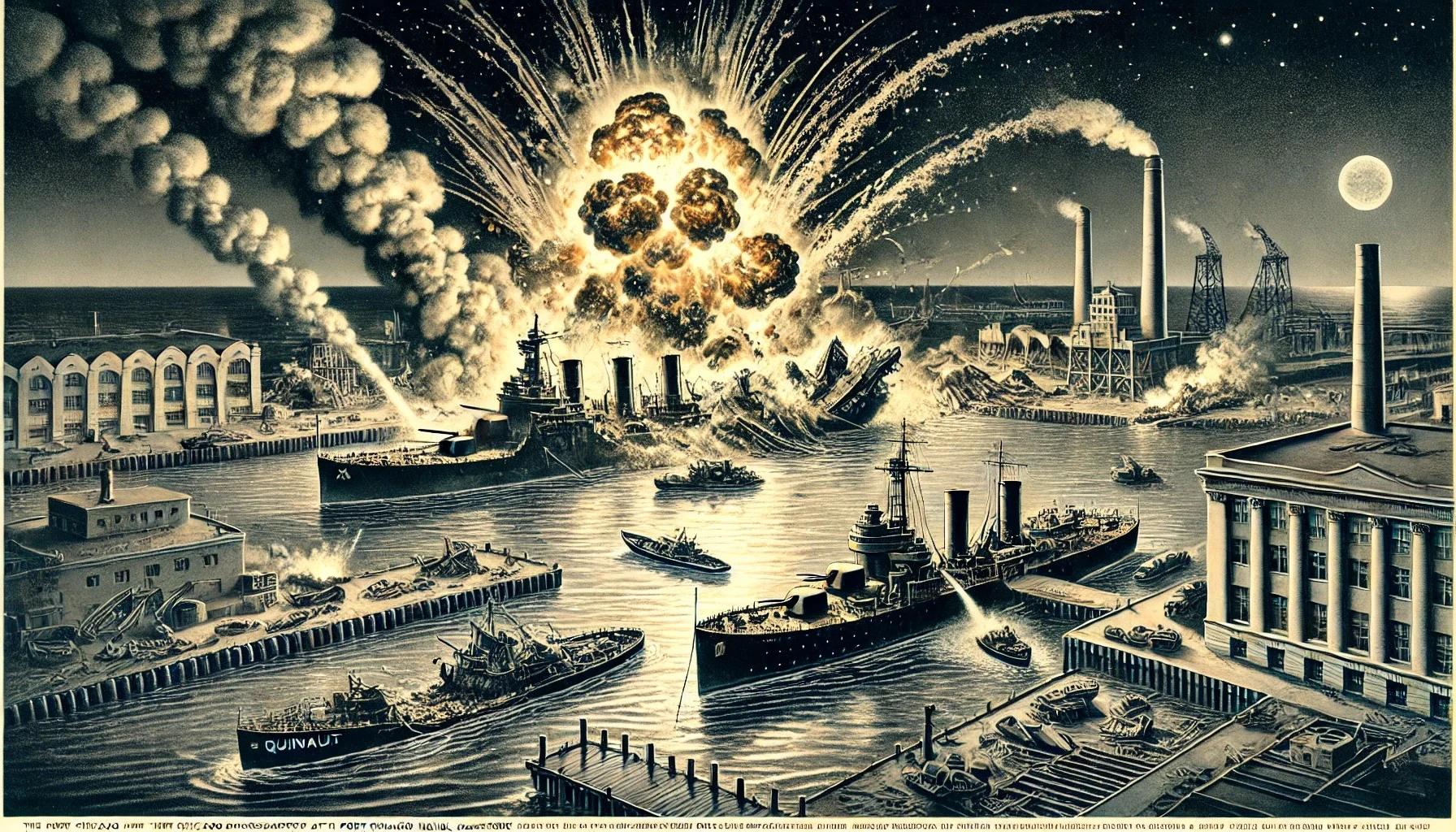
The Port Chicago Disaster
by: The Calamity Calendar Team
July 17, 1944
A Fateful Night in Port Chicago
On the night of July 17, 1944, the quiet calm of Port Chicago, California, was shattered by an explosion so intense it registered as a 3.4 on the Richter scale and was heard up to 200 miles away. The Port Chicago Naval Magazine, a bustling wartime hub for loading ammunition bound for the Pacific Theater, had become the site of one of the most devastating home-front disasters of World War II. The explosion obliterated the SS E.A. Bryan, heavily damaged the SS Quinault Victory, and left a profound mark on American military and civil rights history.
The Ticking Time Bomb
The Port Chicago Naval Magazine was critical to the war effort, shipping vast amounts of ammunition to support Allied operations. The facility’s workforce predominantly consisted of African American enlisted men, overseen by white officers. Despite the hazardous nature of their work, these men received little to no formal training on handling explosives. They were expected to meet tight deadlines, often at the expense of safety.
At 10:18 PM, while loading munitions onto the SS E.A. Bryan and the SS Quinault Victory, a massive explosion tore through the ships and the surrounding area. The exact cause of the blast remains speculative, but mishandling of the munitions, likely due to inadequate training and intense pressure, is widely believed to be the catalyst.
Destruction and Loss
Thanks for subscribing!
The immediate aftermath of the explosion was a scene of utter devastation. The SS E.A. Bryan was destroyed, and while the SS Quinault Victory was not fully loaded, it was still heavily damaged. The pier at Port Chicago was leveled, and buildings in the vicinity were extensively damaged. The human toll was staggering: 320 men lost their lives, including 202 African American sailors, and 390 others were injured.
The sheer force of the explosion not only caused physical destruction but also left deep psychological scars on survivors and first responders. The community and the nation were stunned by the scale of the disaster and the loss of life.
The Economic and Military Impact
The economic ramifications of the Port Chicago disaster were significant. The immediate loss of munitions and naval property disrupted military logistics and operations in the Pacific. The explosion underscored the vulnerabilities in the military’s supply chain and the urgent need for improved safety protocols.
The Struggle for Justice
In the wake of the explosion, the focus quickly shifted to the conditions that led to the disaster. The surviving African American sailors were ordered to return to the same perilous work under unchanged conditions. Fifty of these sailors, later known as the “Port Chicago 50,” refused, citing the unsafe conditions. They were subsequently court-martialed and convicted of mutiny.
This event drew national attention to the racial inequalities within the military. The trial and harsh sentences of the Port Chicago 50 highlighted the broader issues of racial discrimination and injustice. The outcry from civil rights organizations and prominent figures brought the plight of these sailors into the public eye, adding momentum to the burgeoning civil rights movement.
A Legacy of Change
The Port Chicago disaster and the subsequent trial had a lasting impact on military policies and civil rights. The tragedy and the unjust treatment of the Port Chicago 50 contributed to the desegregation of the U.S. Navy. In 1948, President Harry S. Truman issued Executive Order 9981, mandating the desegregation of the armed forces.
In recognition of the historical significance of the event, the site of the Port Chicago disaster was declared a National Memorial in 1994. This designation honors those who lost their lives and acknowledges the broader implications of the disaster for racial equality in the military.
Continuing the Fight for Justice
Efforts to rectify the historical injustices continue to this day. In 2019, legislation was introduced to exonerate the Port Chicago 50, reflecting an ongoing commitment to addressing the wrongs of the past. The Port Chicago disaster remains a poignant reminder of the intersection of war, race, and social justice, and its legacy continues to inspire efforts toward equality and justice in the United States.
Conclusion
The Port Chicago disaster was a tragic event that exposed the dangerous working conditions and systemic racial inequalities faced by African American sailors during World War II. The explosion not only resulted in significant loss of life and property but also served as a catalyst for change, highlighting the need for better safety protocols and contributing to the desegregation of the U.S. military. The legacy of the disaster and the bravery of the Port Chicago 50 continue to resonate, underscoring the ongoing struggle for racial justice and equality.
Stay in the Loop!
Become a Calamity Insider and get exclusive Calamity Calendar updates delivered straight to your inbox.
Thanks! You're now subscribed.